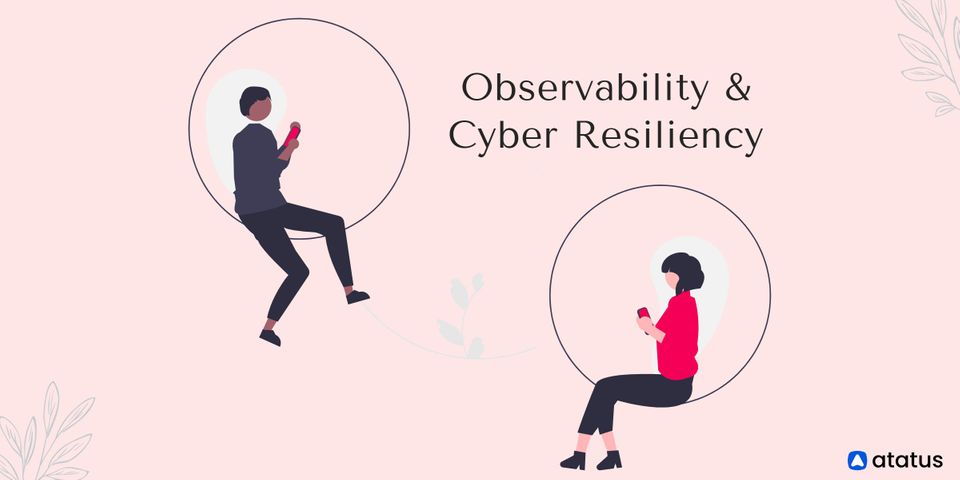Observability and Cyber Resiliency: Things You Need to Know
Every few years, the tech world either rebrands an old term or tries to find a way to use old technology to create new advancements. This rabbit hole is easy to fall into with observability, yet it is distinct from some of its predecessors.
We can now empower businesses to take these additional capabilities on a new and interesting path by simply employing the developed technology in a different way, whether its distributed databases becoming blockchain or software-defined networks becoming intent-based networks.
Although the verdict on observability is still out, it has started to acquire traction and value in the cyber resilience sector, allowing managed service providers to gain more insight into monitoring and management.
We will cover the following:
- What is Cyber Resiliency?
- Cyber Resiliency Factors for Log Data
- Observability for Cyber Resiliency – DDoS attacks
- AI Advantage of Observability for Cyber Resilience
- Why is Cyber Resilience Important?
- Is My Organization Cyber Resilient?
What is Cyber Resiliency?
An organization's capacity to detect, respond to, and recover quickly from an IT security issue is referred to as cyber resilience. Making a risk-focused plan that considers the company will be breached or attacked at some time is part of building cyber resilience.

The ability of an organization to continue operating despite a cyber incident is referred to as cyber resilience. It's critical to recognize that a cyber-attack isn't the only hazard that can strike a company. An automatic directive sent during maintenance can occasionally cause operations to be disrupted and all systems to be taken down.
It's always a good idea to plan ahead for a variety of cyber threats. Cyber resilience aims to prepare for, respond to, and recover rapidly from cyber events. A company's cyber resilience allows it to continue operating with little disruption to workflow and processes.
A good evaluation of the cyber threats that the company is most likely to face is the foundation of a cyber resilience plan. Internal hazards, such as those posed by employees, as well as external risks such as data breaches and ransomware attacks, are among them.
Whatever the source of the disruption, a cyber resilient organization can successfully deal with it by taking the appropriate procedures.
Cyber Resiliency Factors for Log Data
Your system's logs are signs of what's going on. They're merely rows and rows of raw textual data in a database when they're not inside an observability platform. Logs play an important role in both the 'identify' and 'detect' pillars of the NIST Cybersecurity Framework. The explanation for this is straightforward. When it comes to detecting when a system has been compromised, logs are crucial.
How long should your logs be kept?
According to IBM, it takes an average of 197 days for a corporation to detect a security compromise. This means that a hacker may remain undiscovered in your system for more than six months.
If you want to be able to recognise and diagnose an attack, you'll need to maintain your log data. As a general rule, all essential system logs (together with any web or application-facing systems) should be kept for at least a year.
However, with the average cost of a data breach expected to be $3.86 million in 2020, and knowing that containing a breach in under 30 days will save you $1 million, it might be worth paying a bit more on log storage.
Keeping Your Logs Safe
If logs are one of the key methods for identifying or assessing the impact of a security breach, you must ensure that they are stored securely. If you suspect a security breach, this makes forensic investigation of all relevant data much easier. As part of your agreement, some cyber insurance companies may mandate that your logs be preserved in a specific manner.
Log Air-Gapping
Traditionally, organisations have stored log data on the same system or a related system as the one being monitored for ease and affordability. Unfortunately, this approach has the potential to cause more harm than good. Hackers are increasingly modifying or erasing logs to hide their footprints as hacking assaults get more sophisticated.
Audit Log Immutability
It's crucial to maintain your logs safe for the same reasons mentioned above. Taking further efforts, such as providing log file immutability, is an important factor for cyber resilience.
Security audits, such as SOC2, frequently need immutable audit logs. Because audit logs are frequently evidence of which user accessed which database or application, or modified essential configurations, immutability should be considered.
Sensitive Data in Logs
It's a big no-no to keep sensitive info in logs.

Log data containing credit card numbers, passwords, or other personally identifiable information that isn't properly masked or encrypted might pose serious problems. You can prevent security breaches in log data in a few different ways.
Password hashing, encryption, and salting are all techniques for making your log data less sensitive. However, it may take a few more serious cyber-attacks for enterprises to treat log data with the same level of protection as production data.
Observability for Cyber Resiliency – DDoS Attacks
There was a 20% increase in DDoS attacks from 2019 to 2020. Netscout even went so far as to blame the epidemic on this rise, claiming that users have become unduly reliant on eCommerce and streaming services, both of which are ideal targets for such attacks.
A DDoS (distributed denial of service) attack occurs when a single malicious actor or group attempts to overload a platform or service with traffic from an uncontrollable and unpredictable number of sources.
Cloudflare is one of the most well-known providers of enterprise-grade DDoS prevention. To control and mitigate such attacks, it can be utilised in concert with other components of your system, such as network load balancers.
AI Advantage of Observability for Cyber Resilience
Hackers can remain unnoticed in your system for months at a time. "Establish baseline behaviours for individuals, data, devices, and applications," according to the NIST Cybersecurity Framework's "detect" pillar. This is because you need to know what normal looks like in order to spot criminal conduct.
The challenge with a loosely linked multi-component microservices architecture is that it generates data from a large number of parts, devices (in the case of IoT), applications, platforms, users, and networks. Compiling this data and establishing a baseline clever enough to deal with varied fluctuations would be extremely difficult to do manually.
Why is Cyber Resilience Important?
The objective of cyber resilience is to use attack intelligence to help a company change its business processes and cyber capabilities to become more cyber resilient.
- Keeping the Business Running Smoothly
A cyber-attack can damage an organisation, slowing operations or, in the worst-case scenario, bringing the company to a halt. If a virus, malware, or ransomware slips through the gaps, being prepared for attacks ensures that your organisation is protected from unwanted disruptions and that you can get back on track with minimal downtime. - Protecting Customer Data
No matter what industry you're in, you have some type of digitised client data. This implies that you are in charge of the data. Failure to keep data secure can result in penalties, lawsuits, and a loss of client confidence in your company. - Observance of Data Protection and Compliance Regulations
You must comply with many regional such as GDPR and industry-specific such as HIPAA data management rules. Building a solid cyber resilient architecture for data protection and security is an excellent method to ensure your workflows remain compliant. - Gaining Customer Trust
Customers are becoming increasingly interested in learning how you store their data and what safeguards you have in place to protect it. Customers will be more convinced that you understand the risks and have safeguards in place to secure their data at all times if you have a strong cyber resilience structure in place.
Is My Organization Cyber Resilient?
This question does not have a one-size-fits-all response. You may already have numerous systems in place to help you defend against a cyber-attack. A cyber resiliency plan, on the other hand, should take into account a variety of factors such as your industry, company size, local and other legislation, and so on.
To provide total protection, your company's business leaders and C-level executives should determine which functions are the most vital. To keep the organization running during the attack, all of these functions must be protected.
In the event of a threat, it's also critical to create a plan of action that specifies who is responsible for what. When you combine all of these factors, you should be able to create a comprehensive defence system that can withstand both internal and external threats.
Conclusion
We've discussed how to handle monitoring data to become more cyber resilient in this article. When it comes to tracking down an attacker or diagnosing a security breach, logs will be your closest friend. As a result, they must be treated with the same caution and attention as production data. Organizations that detect cyber-attacks in less than 30 days save an average of $1 million, and it's your records that will help you get there.
We've also looked at how you may use monitoring data to strengthen your company's cyber resiliency. You can gain a genuine understanding of when something is wrong in your system if you monitor everything, not just firewalls and security components. This is one of the most basic observability principles.
When done correctly, observability allows you to analyse divergent components and their performance within your system. This is extremely useful for cyber resilience, such as in the event of a DDoS attack.
Monitor Your Entire Application with Atatus
Atatus is a Full Stack Observability Platform that lets you review problems as if they happened in your application. Instead of guessing why errors happen or asking users for screenshots and log dumps, Atatus lets you replay the session to quickly understand what went wrong.
We offer Application Performance Monitoring, Real User Monitoring, Serverless Monitoring, Logs Monitoring, Synthetic Monitoring, Uptime Monitoring, and API Analytics. It works perfectly with any application, regardless of framework, and has plugins.

Atatus can be beneficial to your business, which provides a comprehensive view of your application, including how it works, where performance bottlenecks exist, which users are most impacted, and which errors break your code for your frontend, backend, and infrastructure.
If you are not yet a Atatus customer, you can sign up for a 14-day free trial .
#1 Solution for Logs, Traces & Metrics
APM
Kubernetes
Logs
Synthetics
RUM
Serverless
Security
More



![New Relic vs Splunk - In-depth Comparison [2025]](/blog/content/images/size/w960/2024/10/Datadog-vs-sentry--19-.png)
![New Relic vs Sentry - Which Monitoring Tool to Choose? [2025]](/blog/content/images/size/w960/2024/10/VS--1-.png)
![Splunk vs Prometheus: A Side-by-Side Comparison [2025 Guide]](/blog/content/images/size/w960/2024/08/Datadog-vs-sentry--13-.png)